
Joseph William Ashy, is a retired United States Air Force general who was commander in chief of North American Aerospace Defense Command and United States Space Command, and commander of Air Force Space Command, headquartered at Peterson Air Force Base, Colorado. As commander of NORAD, General Ashy was responsible for the air sovereignty of the United States and Canada, as well as for providing tactical warning and attack assessment. As USCINCSPACE, he commanded the unified command responsible for directing space control and support operations including theater missile defense. As COMAFSPC, he directed satellite control, warning, space launch and ballistic missile operations missions through a worldwide network of support facilities and bases.

Patrick K. Gamble is a retired president of the University of Alaska and a retired Air Force general whose assignments included service as Commander, Pacific Air Forces, Hickam Air Force Base, Hawaii.
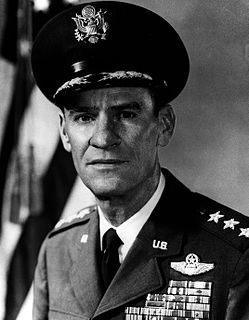
Jay Thorpe Robbins was a career officer in the United States Air Force who rose to the rank of lieutenant general. He was also a United States Army Air Forces fighter ace of World War II.

Carlos Maurice Talbott was a United States Air Force officer who attained the rank of lieutenant general and was vice commander in chief of the Pacific Air Forces, headquartered at Hickam Air Force Base.

Jimmie Vick Adams is a retired United States Air Force four-star general who served as commander in chief, Pacific Air Forces (CINCPACAF), from 1991 to 1993.
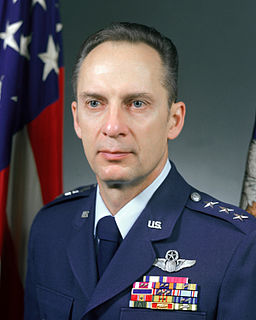
General John Louis Piotrowski is a retired United States Air Force four-star general who served as Vice Chief of Staff, U.S. Air Force (VCSAF), from 1985 to 1987; and Commander in Chief, North American Aerospace Defense Command/Commander in Chief, U.S. Space Command (CINCNORAD/USCINCSPACE), from 1987 to 1990.

Brigadier General William D. Curry Jr was a retired United States Air Force officer. He was a command pilot with over 6,500 flying hours, serving in World War II, the Korean and Vietnam Wars.
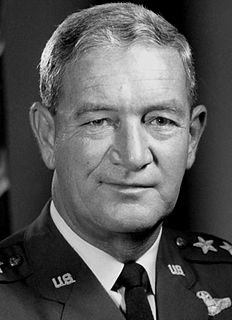
Timothy Francis O'Keefe was a general in the United States Air Force and the commander of various units over the years.

William John Evans was a general in the United States Air Force and commander of Allied Air Forces Central Europe.
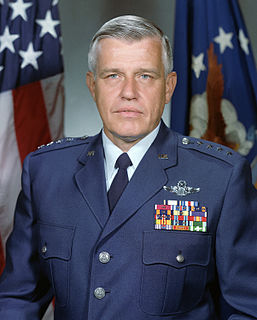
Robert Dale Russ was a United States Air Force general and commander of the Tactical Air Command.
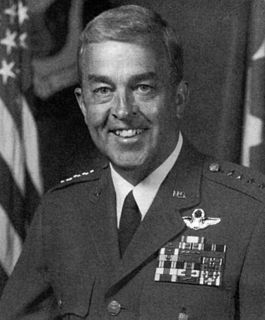
Jack Irvin Gregory is a former general in the United States Air Force and the former commander in chief of the Pacific Air Forces.
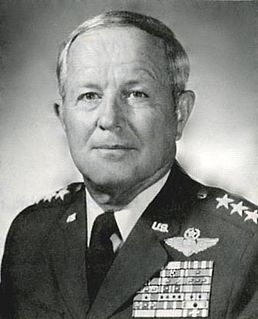
Freddie Lee Poston was an American lieutenant general who was chief of staff, United States Pacific Command, Camp H. M. Smith, Hawaii. Poston is responsible to the commander in chief Pacific for management of key military staff activities requiring coordinated Air Force, Navy, Army and Marine Corps operations throughout the Pacific Command. The Pacific Command is the United States' largest unified command, encompassing some 100 million square miles from the West Coast of the Americas to the east coast of Africa and from the arctic to the Antarctic.
Anderson W. Atkinson was a major general in the United States Air Force.
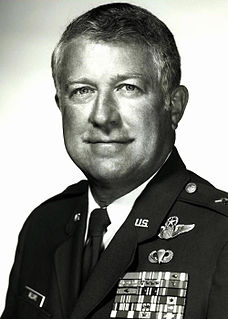
Gordon E. Williams is a retired United States Air Force officer. A command pilot with more than 4,000 flying hours, he flew numerous Air Force and Navy aircraft. Upon his retirement on 1 August 1988, he was the director for plans and policy, J-5, Headquarters United States European Command, Stuttgart-Vaihingen, West Germany.
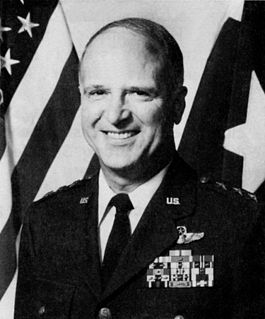
James Robert Brown was a lieutenant general in the United States Air Force who served as vice commander of Tactical Air Command, with headquarters at Langley Air Force Base, Virginia. The command comprises more than 118,000 military and civilian personnel, stationed at 18 major Tactical Air Command installations and other units in the United States, Panama, Okinawa and Iceland. Tactical Air Command was the operational combat organization for 74,000 Air National Guard and Air Force Reserve personnel throughout the United States.

Craven C. Rogers Jr. was a lieutenant general in the United States Air Force who served as deputy commander in chief of the U.S. Central Command at MacDill Air Force Base, Florida. The command was tasked with achieving United States national objectives in Southwest Asia, the Persian Gulf, and the Horn of Africa. Rogers was born in 1934, in Galveston, Texas. He earned a bachelor of science degree in engineering from the U.S. Military Academy in 1957 and a master's degree in business administration from The George Washington University. He completed Squadron Officer School in 1962 and the Industrial College of the Armed Forces in 1973. Upon graduation from the academy he was commissioned as a second lieutenant in the Air Force. After completing pilot training in September 1958 he was assigned to Tactical Air Command at Williams Air Force Base, Ariz., for gunnery training in the F-86F. With the phaseout of the F-86F, Rogers transferred in June 1959 as an instructor pilot to Air Training Command, Vance Air Force Base, Oklahoma. He completed F-101A transition training in September 1964 and then was assigned as a tactical fighter pilot with the 91st Tactical Fighter Squadron, Royal Air Force Station Bentwaters, England. In 1965 his squadron became the first unit in the United States Air Forces in Europe to transition to the F-4. Rogers assumed duties in the Standardization and Evaluation Section of the 81st Tactical Fighter Wing at Bentwaters in November 1966. In September 1967 he transferred to Nellis Air Force Base, Nevada, where he completed the F-4 Fighter Weapons School. In January 1968 he was assigned to the 557th Tactical Fighter Squadron, 12th Tactical Fighter Wing, Cam Ranh Bay Air Base, South Vietnam, as a flight commander and squadron weapons officer. He subsequently served as the wing weapons officer and assistant chief of weapons and tactics for 12th Tactical Fighter Wing. He flew 255 combat missions and 435 combat flying hours in the F-4C. He returned from Southeast Asia in February 1969 and was assigned to the Fighter and Reconnaissance Manning Section, Air Force Military Personnel Center, Randolph Air Force Base, Texas. He became chief of the section in 1971. Upon graduation from the Industrial College of the Armed Forces in August 1973, Rogers became deputy commander for operations, 1st Tactical Fighter Wing, MacDill Air Force Base, Florida. In June 1975 he transferred to Headquarters United States Air Force, Washington, D.C., as chief, Tactical Division, Directorate of Operational Requirements, Office of the Deputy Chief of Staff, Research and Development. In July 1977 Rogers was assigned as vice commander of the 4th Tactical Fighter Wing, Seymour Johnson Air Force Base, North Carolina. In June 1978 he became commander of the wing. He returned to Air Force headquarters in July 1980 and served as military assistant to the secretary of the Air Force. From June 1983 to July 1985 he was commander of United States Air Forces Korea; commander, United Nations Command Air Component; and commander, 314th Air Division, with headquarters at Osan Air Base, South Korea. He also was commander of the Korean Air Defense Sector, director of readiness and combat operations, and chief of staff of the Air Component Command/Combined Forces Command. Rogers then transferred to Hickam Air Force Base, Hawaii, as vice commander in chief, Pacific Air Forces. In December 1986 Rogers returned to Osan Air Base as commander, 7th Air Force; deputy commanding general, U.S. Forces Korea (Seoul); and deputy commander in chief, United Nations Command (Seoul). He is a command pilot with 5,200 flying hours. His military awards and decorations include the Defense Distinguished Service Medal with oak leaf cluster, Distinguished Service Medal, Legion of Merit with two oak leaf clusters, Distinguished Flying Cross with oak leaf cluster, Bronze Star Medal, Meritorious Service Medal with oak leaf cluster, Air Medal with 13 oak leaf clusters, Air Force Commendation Medal, Korean Order of National Security Merit (Chunsu) and Korean Order of National Security Merit (Kuksun). He was promoted to lieutenant general January 1, 1987, with same date of rank. He retired on April 1, 1991 and died on August 4, 2016.
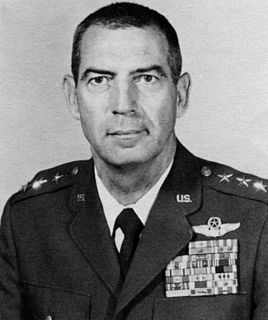
Walter Daniel Druen Jr. was a lieutenant general in the United States Air Force who served as commander of Allied Air Forces Southern Europe and deputy commander in chief, U.S. Air Forces in Europe (USAFE), Southern Area, with headquarters at Naples, Italy from July 1981 until his retirement in 1982.

John A. Bradley was a lieutenant general in the United States Air Force who served as Commander of the United States Air Force Reserve Command, Headquarters U.S. Air Force, Washington D.C., and commander, Headquarters Air Force Reserve, a separate operating agency located at Robins Air Force Base, Georgia. As chief of Air Force Reserve, he served as the principal adviser on Reserve matters to the Air Force Chief of Staff. As commander of AFRES, he had full responsibility for the supervision of U.S. Air Force Reserve units around the world. He served in this position from November 1994 to June 1998.

Howard Wesley Leaf was a United States Air Force lieutenant general who served as a fighter pilot during the Korean War and Vietnam War and retired as assistant vice chief of staff at the Pentagon in 1984.

Major General Philip William Nuber of United States Air Force, was director of the Defense Mapping Agency from December 1994 to May 1996.



















